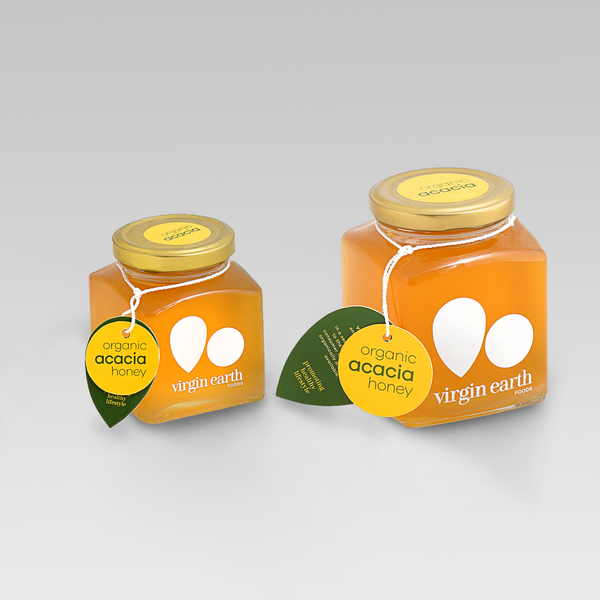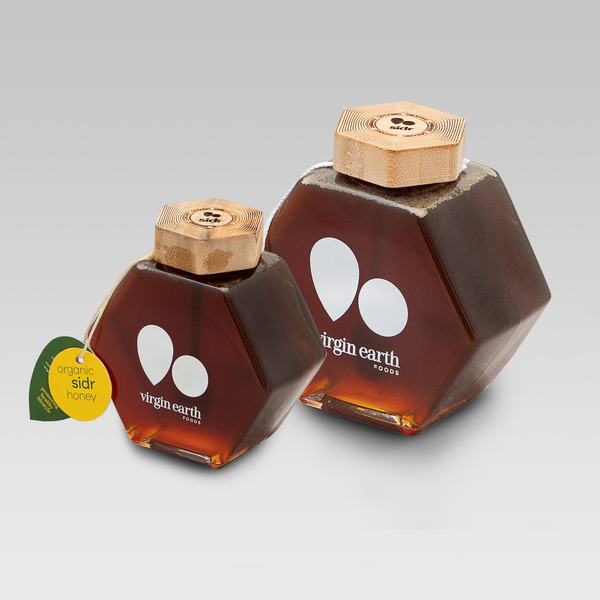Virgin Earth Foods
organic Acacia Honey
Couldn't load pickup availability
Acacia
Acacia Honey is the honey obtained from the blossom of Acacia tree (Babool, Kikar). Acacia flowering generally takes place twice, once during June-July and second from November to December.
Share






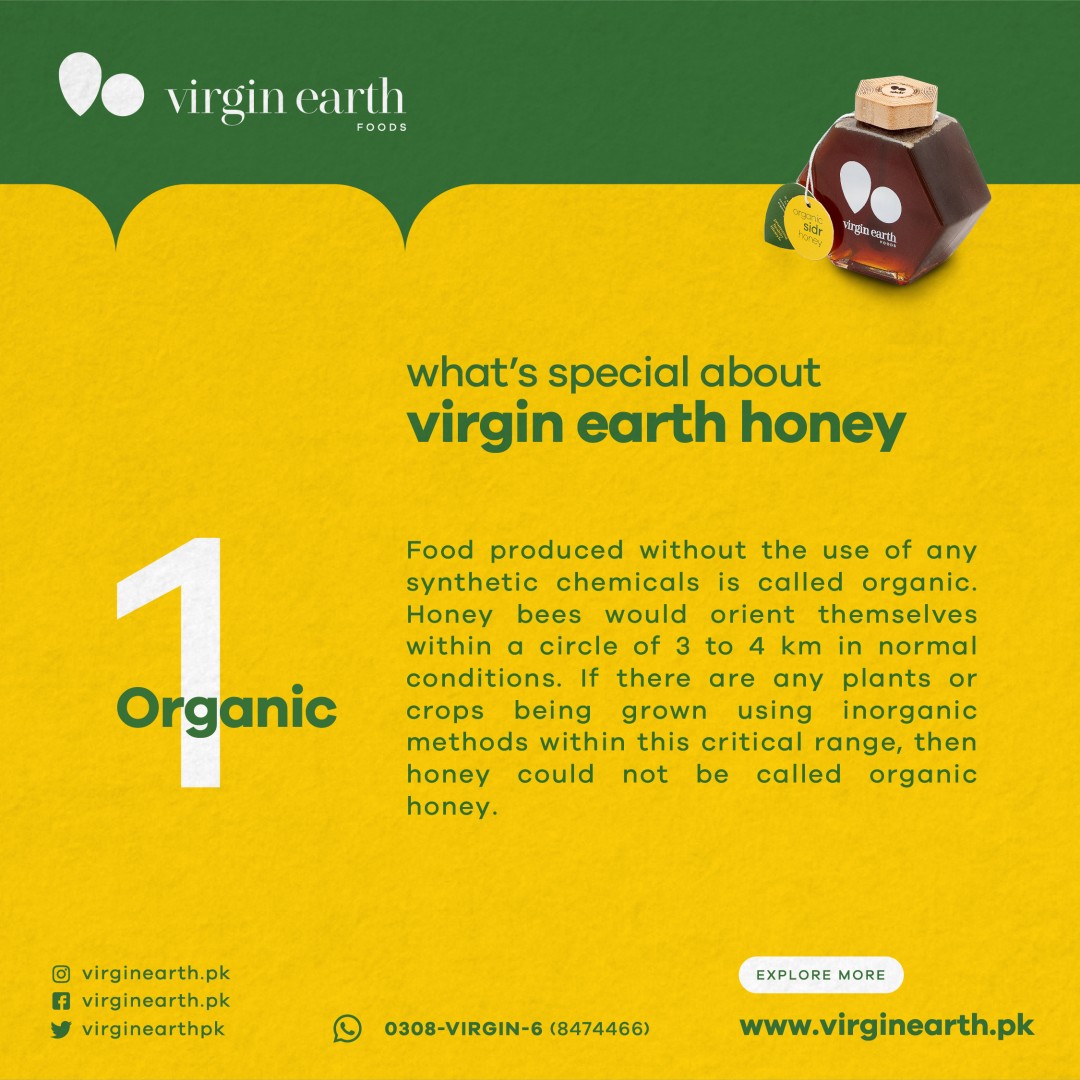
Food produced without the use of chemical fertilizers, pesticides, antibiotics, growth stimulants or any other artificial chemicals is called organic.
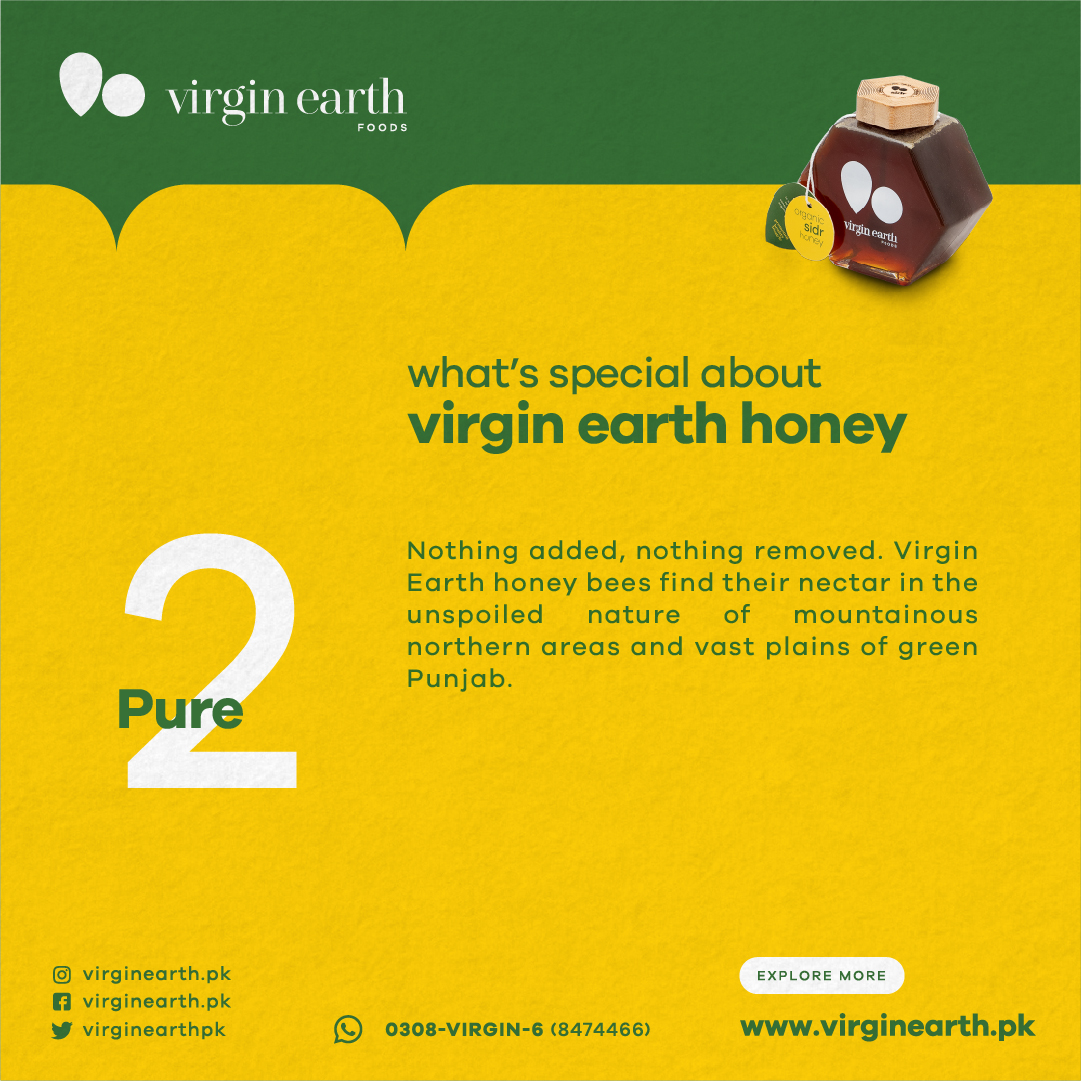
Nothing added, nothing removed. Virgin Earth honey bees find their nectar in the unspoiled nature of mountainous northern areas and vast planes of green Punjab.

Our honey is presented to you as it exists in nature and is not made or caused by humankind. The bees naturally collect nectar and pollen to make honey, using a technique that was perfected within the last 40 million years.
The production process applies the absolute minimum in technology, it preserves the traditional ways of harvesting honey and guarantees a sustainable and natural approach.
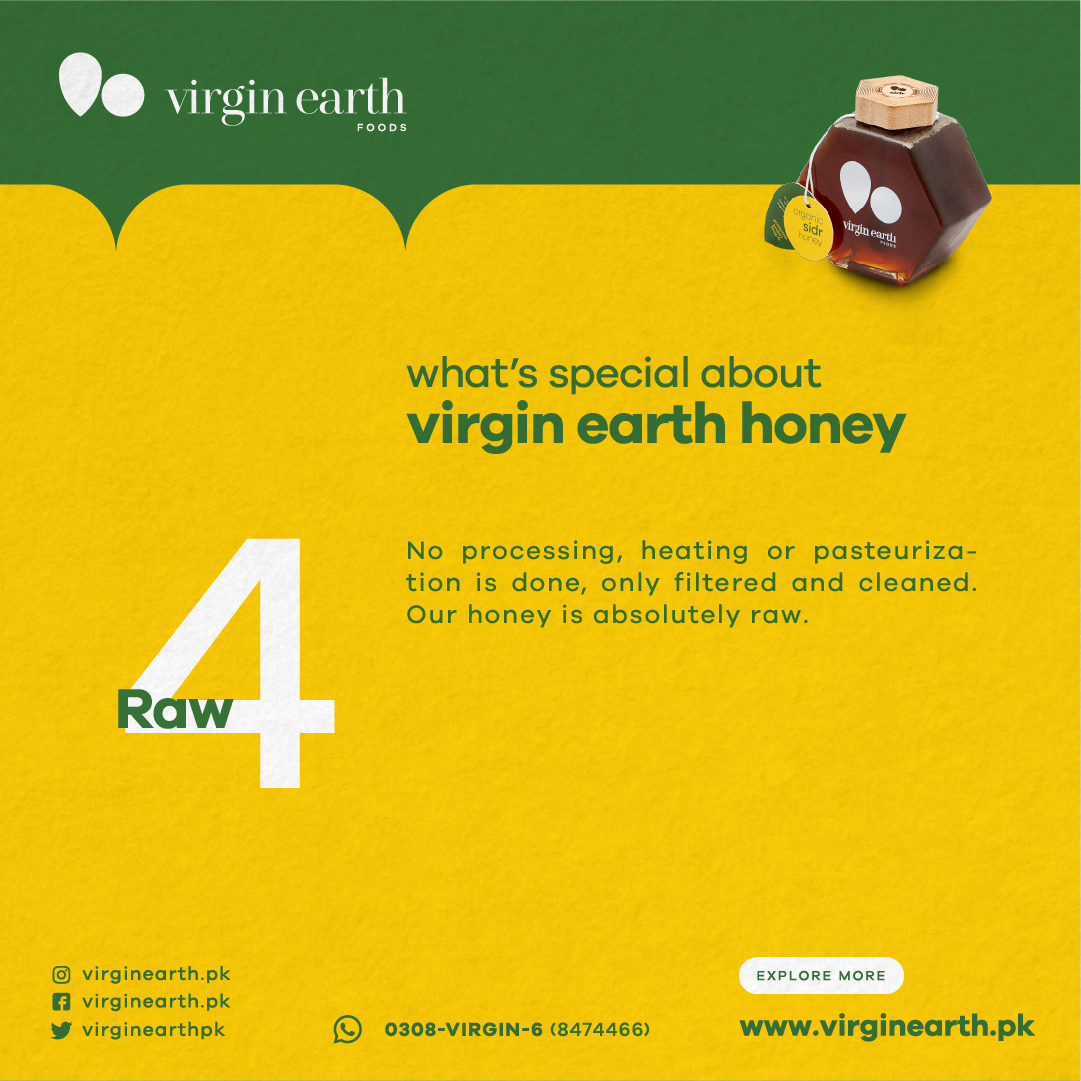
No processing, heating or pasteurization is done, only filtered and cleaned. Our honey is absolutely raw.
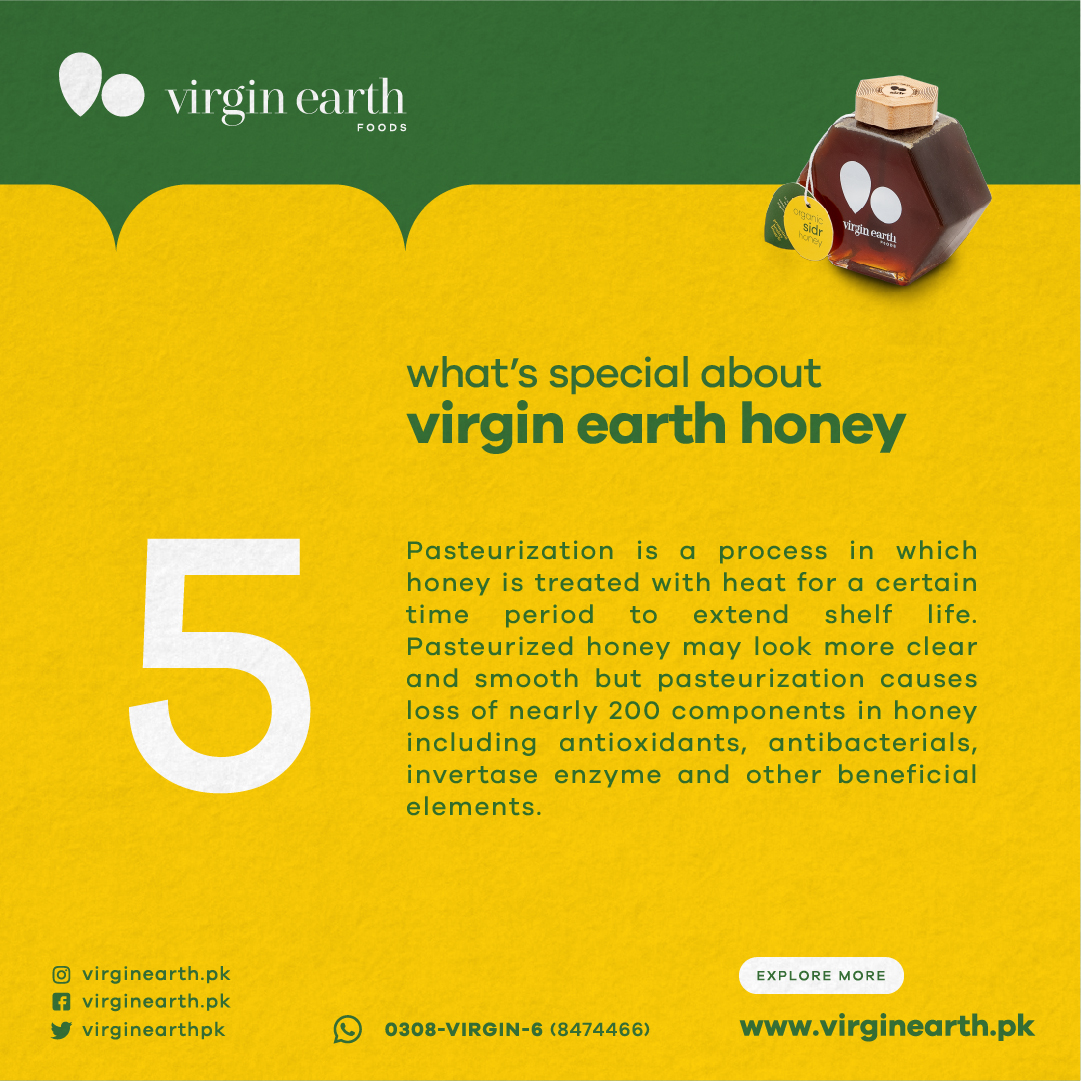
Pasteurization is a process in which honey is treated with heat for a certain time period to extend shelf life. Pasteurized honey may look more clear and smooth but pasteurization causes loss of nearly 200 components in honey including antioxidants, antibacterials, invertase enzyme and other beneficial elements.
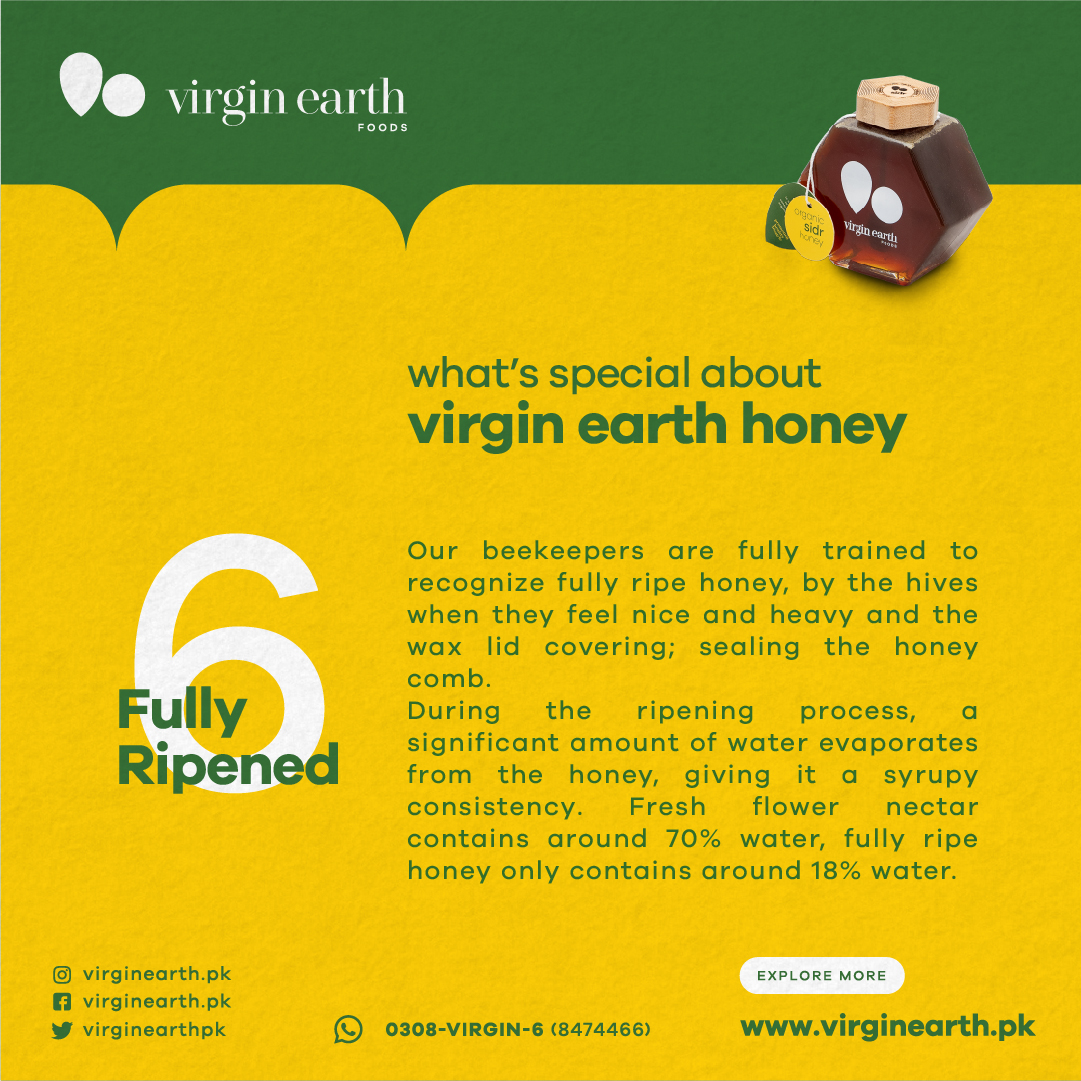
Our beekeepers are fully trained to recognize fully ripe honey by the wax lid covering the honey comb. When the hives feel nice and heavy, and the honeycomb is completely sealed, this is an indication of fully ripe honey, the beekeeper will then begin collecting the honey.
During the ripening process, a significant amount of water evaporates from the honey, giving it a syrupy consistency. Fresh flower nectar contains around 70% water, fully ripe honey only contains around 18% water.
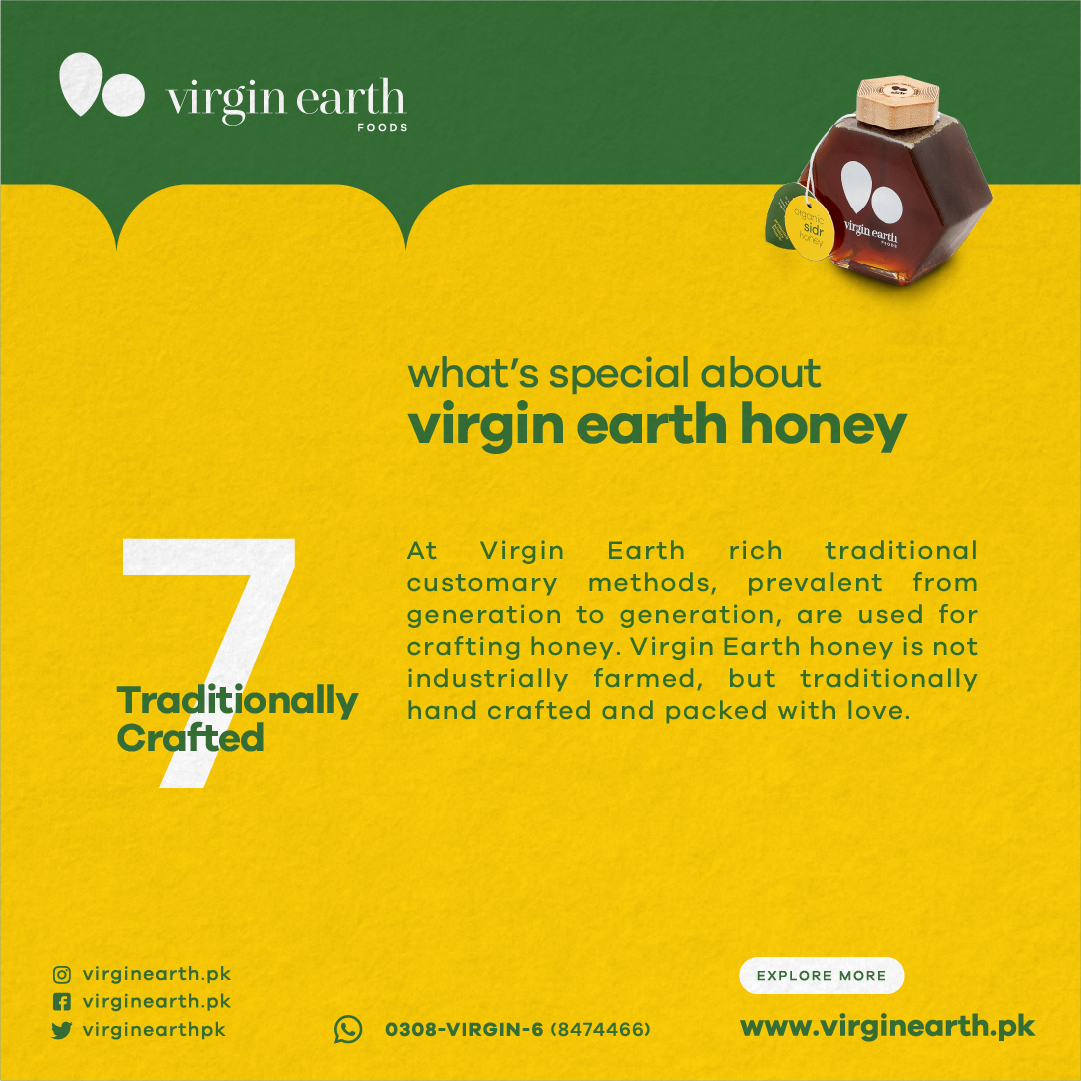
At Virgin Earth rich traditional customary methods, prevalent from generation to generation, are used for crafting honey. Virgin Earth honey is not industrially farmed in bulk quantities but have a limited quantity which is traditionally hand crafted and packed with love.
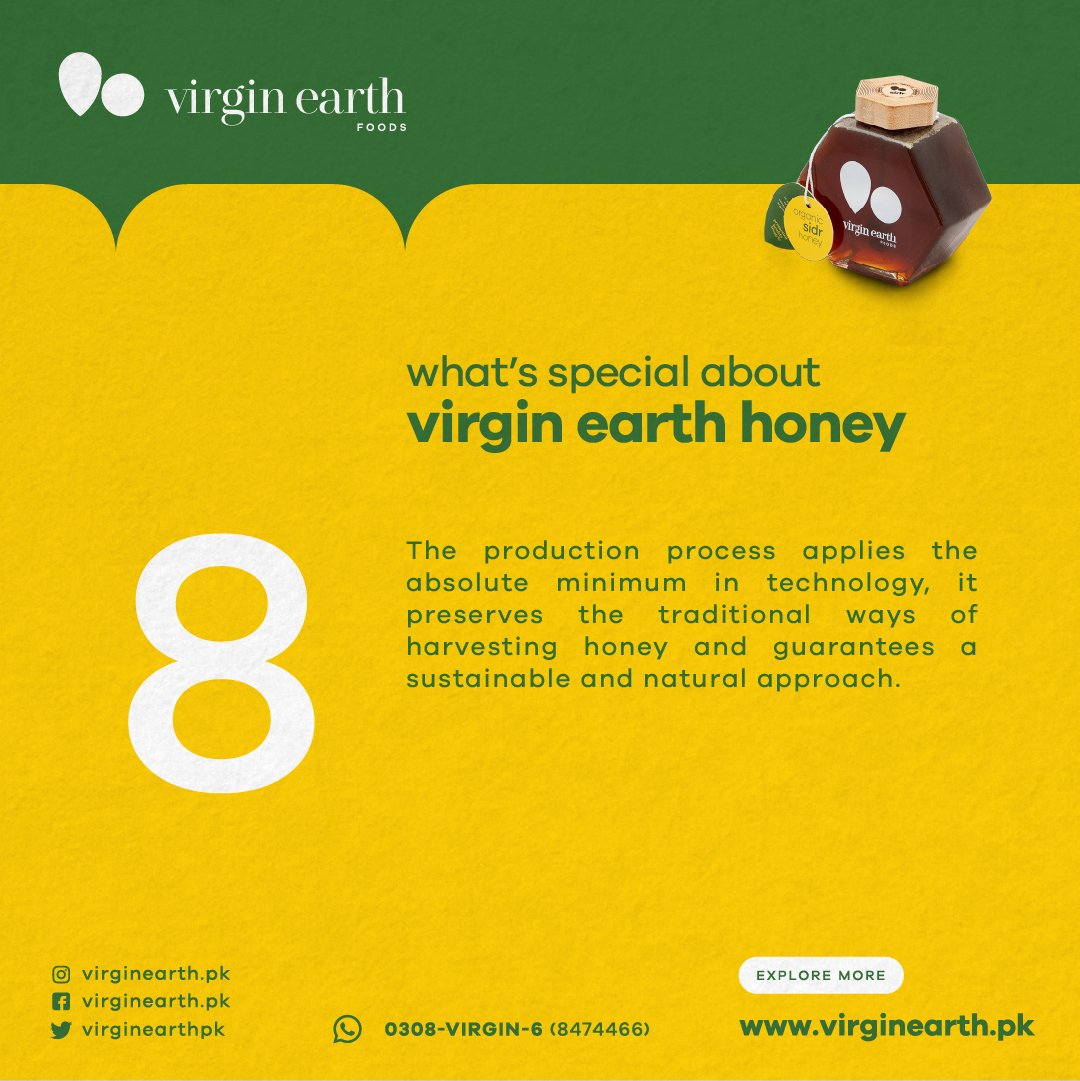
The production process applies the absolute minimum in technology. It preserves the traditional ways of harvesting honeyand guarantees a sustainiable and natural approach.
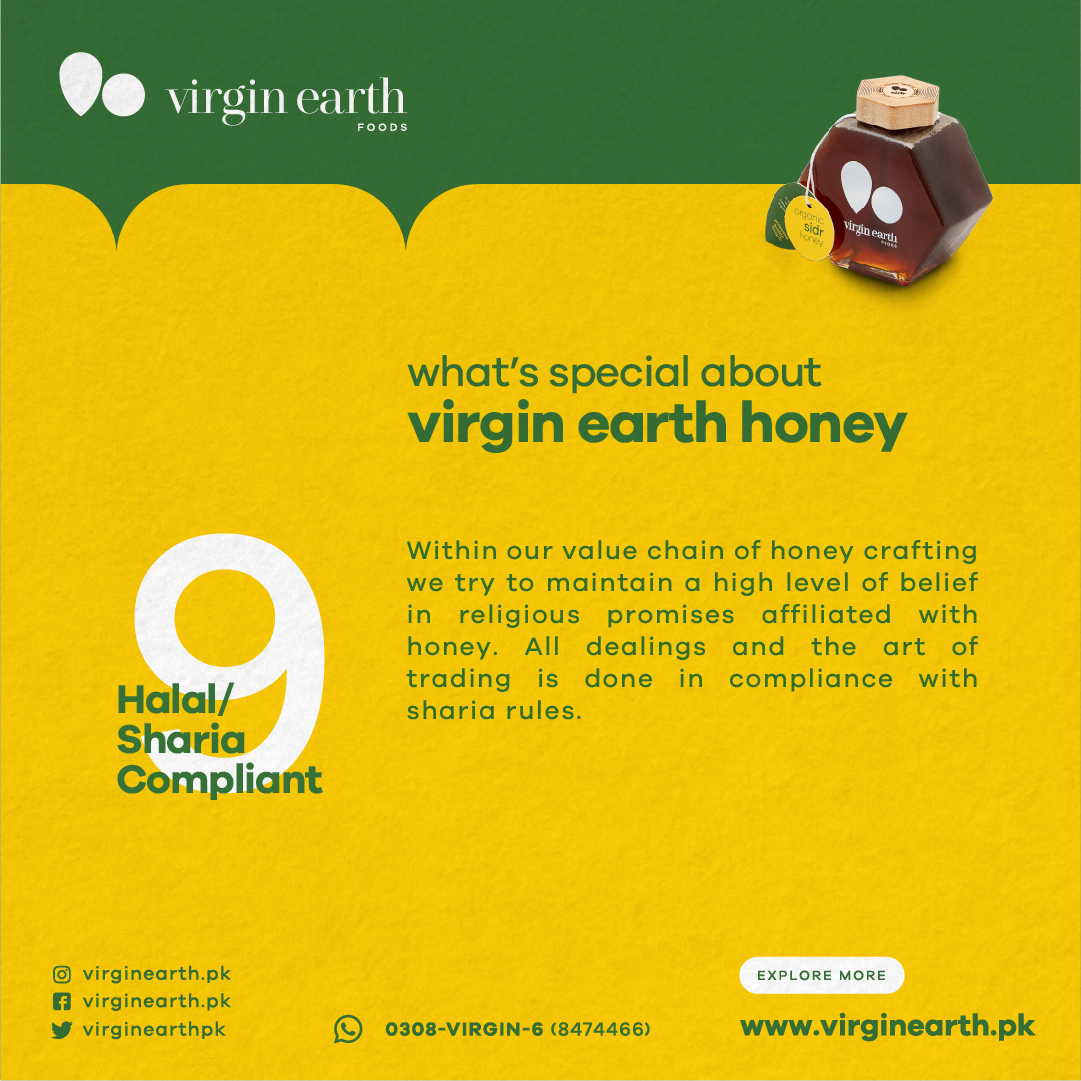
Within our value chain of honey crafting we try to maintain high level of belief in religious promises affiliated with honey. All dealings and the art of trading is done in complacence with sharia rules.
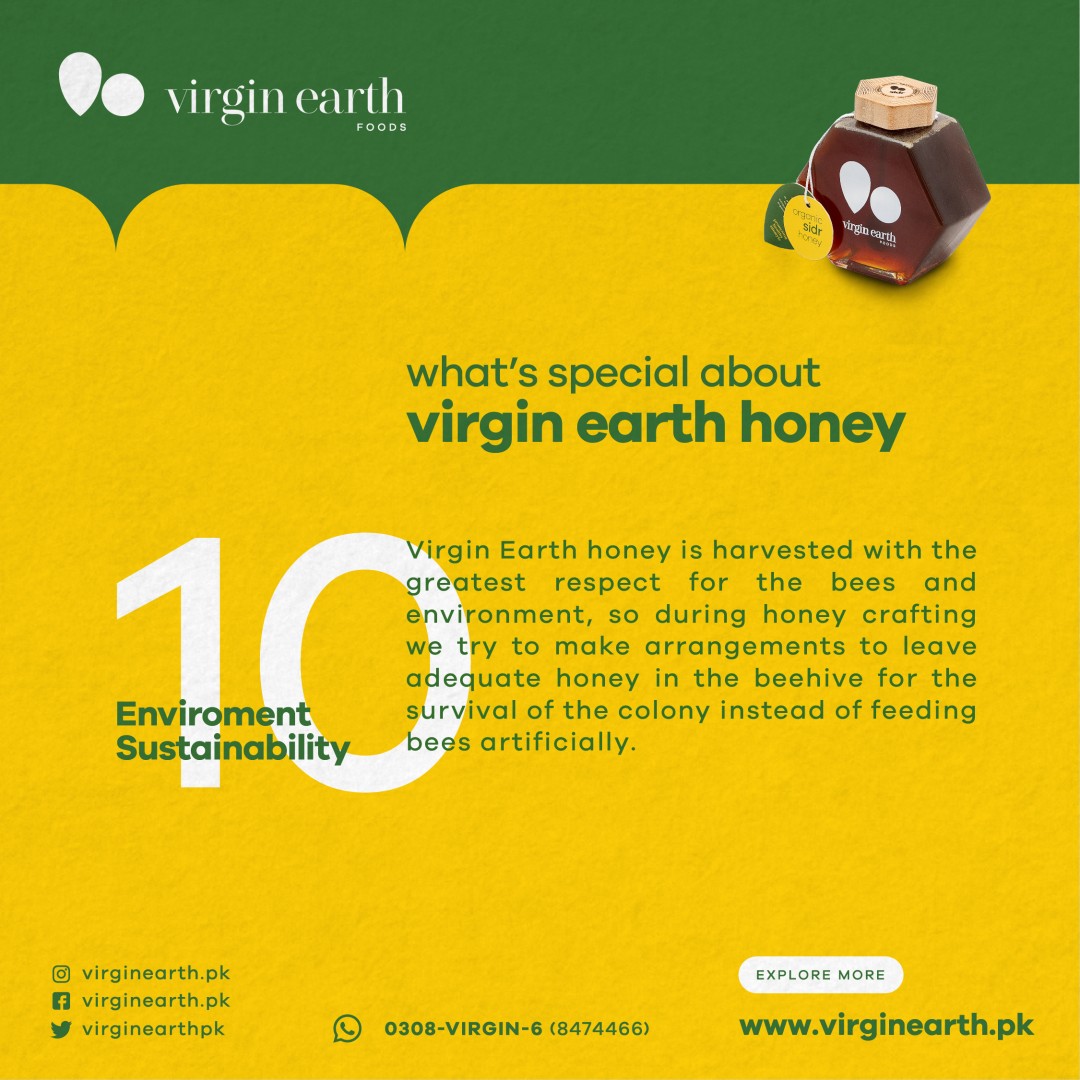
Virgin Earth honey is harvested with the greatest respect for the bees and environment. This honey is a noble gift from nature. Also during honey crafting we try to make arrangements to leave adequate honey in the beehive for the survival of the colony instead of feeding bees artificially.
Limited time | Limited quantities
organic Sidr Honey
Sidr honey is a monofloral honey. The bees collect the nectar from flowers of the tree before they turn into fruit. With time, this honey thickens, darkening in colour and improving in quality. It has a delicate fragrance and is comparatively less sweet than other types of honey.
organic Wild Flower Honey
Wildflower is the flower of a plant that normally grows in fields, forests, etc., without deliberate cultivation. In other words, there’s no specific genus or family for wildflowers; they’re any flower that grows on its own in the wild – so the taste, aroma and flavor will vary from season to season.
organic Acacia Honey
Acacia Honey is the honey obtained from the blossom of Acacia tree (Babool, Kikar). Acacia flowering generally takes place twice, once during June-July and second from November to December.
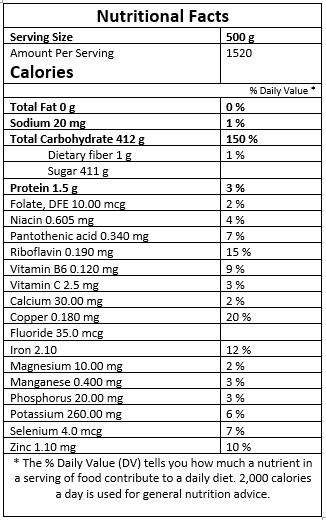
Health Benefits
Raw honey has been used as a folk remedy throughout history and has a variety of health benefits and medical uses. It’s even used in some hospitals as a treatment for wounds. Many of these health benefits are specific to raw, or unpasteurized, honey. Most of the honey you find in grocery stores is pasteurized. The high heat given during pasteurization kills many of the beneficial nutrients and living enzymes inherently found in this lovely golden liquid. Virgin Earth offers raw honey with trust. Here are some health benefits raw honey has to offer.
- Fights Free Radical Damage : Phytonutrients are compounds found in plants that help protect the plant from harm. For example, some keep insects away or shield the plant from ultraviolet radiation. The phytonutrients in honey are responsible for its antioxidant properties, as well as its antibacterial and antifungal power. Raw honey is packed with all powerful antioxidants, which fight against cell damage. When harmful agents known as free radicals try to attack your cells through a process called oxidative stress, antioxidants forfeit an electron to keep your cells safe. Free radical damage is associated with aging, inflammatory disorders, and diseases, including cancer. Luckily, honey can help combat these consequences — and there’s science to back it up. They’re also thought to be the reason raw honey has shown immune-boosting benefits.
- Combats Harmful Bacteria : Honey is famous for its antibacterial properties and its ability to combat many types of bacteria, including salmonella and E. coli. Across folk of medicine traditions, it’s been used as a treatment for a variety of bacterial and fungal infections.
During pollen synthesis, bees deposit hydrogen peroxide, a natural antiseptic, into the honey they’re creating. Factor in honey’s low water content and slight acidity, and the harmful microbes don’t stand a chance!
- Calms a Sore Throat and Cough : The idea that honey can soothe a cough isn’t just an old wives’ tale; it’s actually one of the top benefits of eating honey. Researchers have shown that a 2.5-ml dose of honey can be a more effective cough suppressant for children with upper respiratory infections than common cough medicines.
Honey is successful at suppressing coughs thanks to its antibacterial and anti-inflammatory powers. And, because of honey’s viscous consistency, it coats the throat providing a soothing effect.
- Promotes Oral Health : Surprisingly, honey can fend off gingivitis and periodontal disease.
This might seem odd since sugary substances aren’t usually considered suitable for oral health. However, given honey’s natural antibacterial properties, the research suggests that it is more likely to fight off causes of tooth decay than cause cavities.
- Improves Digestive Health : Raw honey is recognized as a prebiotic food, meaning it can nurture the good bacteria living in your gut.
It may also be a remedy for indigestion and ulcers, which is how it’s been used in folk medicine for years. Antibacterial properties make honey a tough match for the Helicobacter pylori (H. pylori) bacteria, which is known to cause stomach ulcers.
- Keeps Blood Glucose Levels in Check : Even though it’s composed of glucose and fructose, honey has a relatively low glycemic index (GI). As a result, when compared to refined sugar, honey can sweeten foods without causing a spike in blood sugar levels. For this reason, people with Type 2 diabetes may be able to enjoy it.
- Helps Fend off Diseases : The phytonutrients found in honey, which contribute to its antioxidant and antibacterial powers, can also give your immune system a boost.
Moreover, since oxidative stress and inflammation can contribute to cardiovascular diseases and cancers, honey actively helps your body prevent heart disease and cancer.
- Bonus: Supports Skin Recovery : In addition to all the benefits of eating honey, certain types can be used in topical treatments. Honey is an approved treatment for wound dressings. It’s known to promote faster tissue regeneration and reduce the chance of infection.
- Honey Also Helps Improve Cholesterol : High LDL cholesterol levels is a strong risk factor for heart disease.
This type of cholesterol plays a major role in atherosclerosis, the fatty buildup in your arteries that can lead to heart attacks and strokes.
Interestingly, several studies show that honey may improve your cholesterol levels. It reduces total and “bad” LDL cholesterol while significantly raising “good” HDL cholesterol. For example, one study in 55 patients compared honey to table sugar and found that honey caused a 5.8% reduction in LDL and a 3.3% increase in HDL cholesterol. It also led to modest weight loss of 1.3%.
- The Antioxidants in It Are Linked to Other Beneficial Effects on Heart Health : Again, honey is a rich source of phenols and other antioxidant compounds. Many of these have been linked to a reduced risk of heart disease.
They may help the arteries in your heart dilate, increasing blood flow to your heart. They may also help prevent blood clot formation, which can lead to heart attacks and strokes.
- Honey Promotes Burn and Wound Healing : Topical honey treatment has been used to heal wounds and burns since ancient Egypt and is still common today.
A review of 26 studies on honey and wound care found honey most effective at healing partial-thickness burns and wounds that have become infected after surgery.
Honey is also an effective treatment for diabetic foot ulcers, which are serious complications that can lead to amputation.
One study reported a 43.3% success rate with honey as a wound treatment. In another study, topical honey healed a whopping 97% of patients’ diabetic ulcers.
Researchers believe that honey’s healing powers come from its antibacterial and anti-inflammatory effects as well as its ability to nourish surrounding tissue.
What’s more, it can help treat other skin conditions, including psoriasis and herpes lesions.
- Protecting the Brain : Some evidence suggests that honey may have antioxidant and anti-inflammatory powers that can benefit the brain. A study found that honey develops protection against brain damage caused by exposure to lead.
In addition, a review states that raw honey may contain ingredients that help fight inflammation in the hippocampus, a part of the brain involved in memory.
Honey may help Prevent Artery Hardening : Another recent paper about honey’s benefits explores its ability to combat artery hardening, a leading cause of death worldwide. Published in 2019, also in the journal Nutrients, the authors point out that honey contains over 180 substances—including natural sugars as well as a plethora of vitamins, minerals, and phytochemicals. Researchers conclude that the antioxidant and anti-inflammatory compounds in honey, in addition to its ability to counter oxidative stress, are the key factors responsible for its protective benefits.







